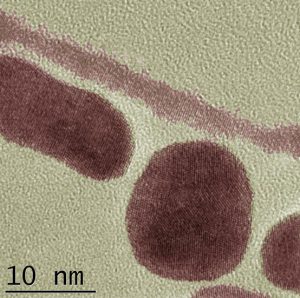
Gold nanorods, as a kind of capsule-like gold nanoparticles with a scale from a few nanometers to hundreds of nanometers, have more peculiar optical properties than spherical gold nanoparticles due to their localized surface plasmon resonance (LSPR) effect. Gold nanorods are biomaterials developed during the same period when gold nanoshells were developed.
- What are Nanorods?
Nanorods are nanostructures that are the object of fundamental and applied research. They may be prepared from carbon, gold, zinc oxide, and many other materials. They are bigger than individual atoms (measured in angstroms, 1 Å = 10−10 m) and also than small molecules. The turning point for nanomaterials research was the discovery of carbon nanotubes in 1991. Their mechanical, electrical, and optical properties depend upon their size, allowing for multiple applications. Also, nanorods may be functionalized for different applications.
- Is a nanorod a nanoparticle?
In nanotechnology, nanorods are a form of nanoscale objects. Each of them has a size range of 1–100 nm. They can be synthesized from metal or semiconductor materials. Nanorods, together with other precious metal nanoparticles, can also be used as therapeutic agents.
- What are gold nanorods used for?
Gold nanorods show great potential for biomedical application due to their smaller size compared with gold nanoshells and they can also be easily synthesized. They also have high absorption coefficient especially within the near-infrared (NIR) region where it is higher than other nanoparticles with narrow spectral bandwidths. Thus they can be applied in photothermal treatment technology, where NIR lasers selectively irradiate nanorods at their resonance wavelengths to cause local heating without causing damage to surrounding (infrared transparent) tissues. In addition, gold nanorods possess unique optical properties that allow them to be used in tandem with light-based therapeutic, imaging or sensing systems to detect and treat diseases.
- How to synthesize gold nanorods?
The synthesis of monodispersed small gold nanorods has attracted much attention for their optical properties and biomedical applications. Many methods have been developed for the synthesis of monodispersed small gold nanorods with different aspect ratios, including the seed-mediated method, the seedless method, and the high-temperature seedless method.
About the author
CD Bioparticles offers a wide range of gold nanorods with different surface coatings and functional groups in multiple aspect ratios. The available aspect ratios give rise to longitudinal surface plasmon resonant (SPR) absorption peaks from 650-1100 nm. Products including Basic Gold Nanorods, Coated Gold Nanorods, Functional Gold Nanorods, Conjugated Gold Nanorods, Fluorescent Gold Nanorods, and Gold Nanorods Conjugation Kits are accessible to all researchers.
Our gold nanorods are available with a variety of surface properties including coated, functionalized and conjugated forms. The ease of surface chemistry of gold nanorods allows conjugation with various biomolecules, such as PEG, silica, DNA, antibodies, etc.
References
An, L., Wang, Y., Tian, Q., & Yang, S. (2017). Small gold nanorods: recent advances in synthesis, biological imaging, and cancer therapy. Materials, 10(12), 1372.
Shaarawy, T. M., Sherwood, M. B., Hitchings, R. A., & Crowston, J. G. (2014). Glaucoma E-Book. Elsevier Health Sciences.
Hamblin, M. R., & Avci, P. (Eds.). (2015). Applications of Nanoscience in Photomedicine. Elsevier.
Meng, L., Zhang, J., Li, H., Zhao, W., & Zhao, T. (2019). Preparation and progress in application of gold nanorods. Journal of Nanomaterials, 2019.
Ghassan, A. A., Mijan, N. A., & Taufiq-Yap, Y. H. (2020). Nanomaterials: an overview of nanorods synthesis and optimization. Nanorods and Nanocomposites, 11.
